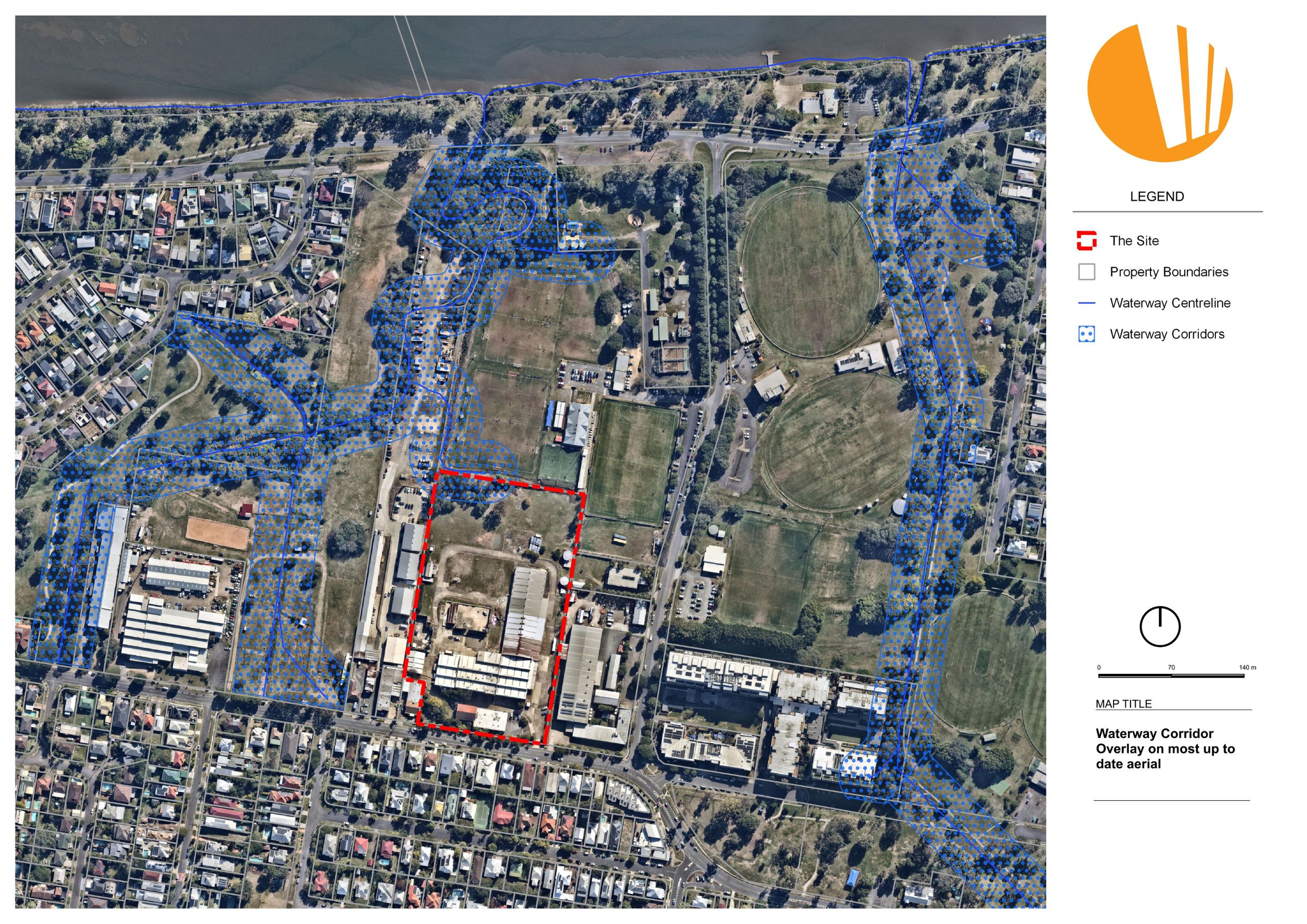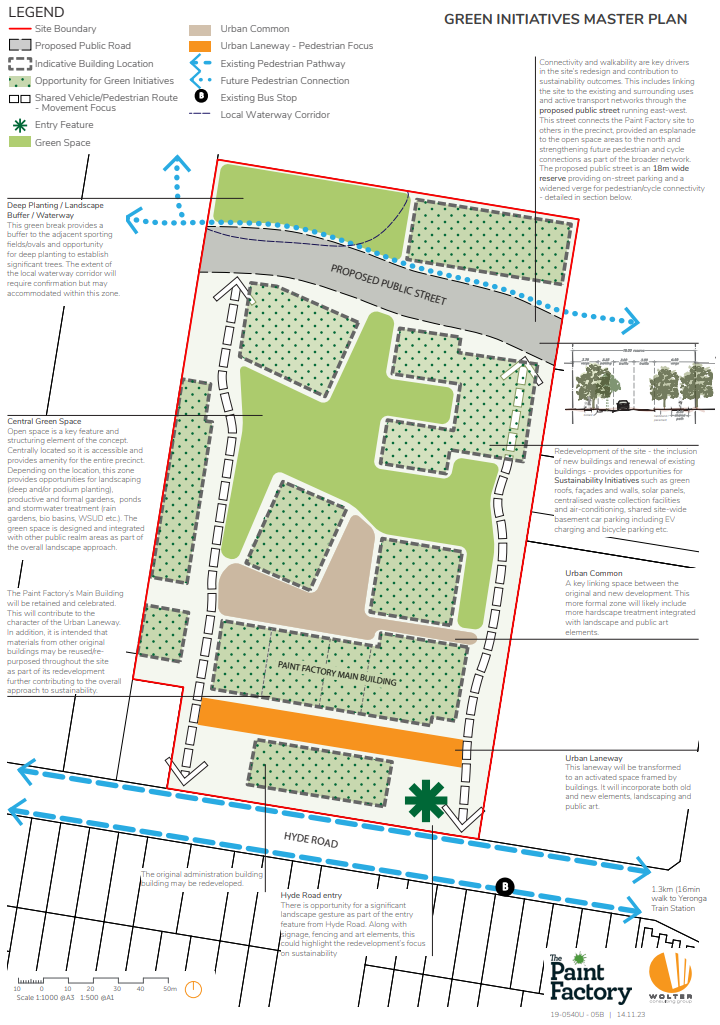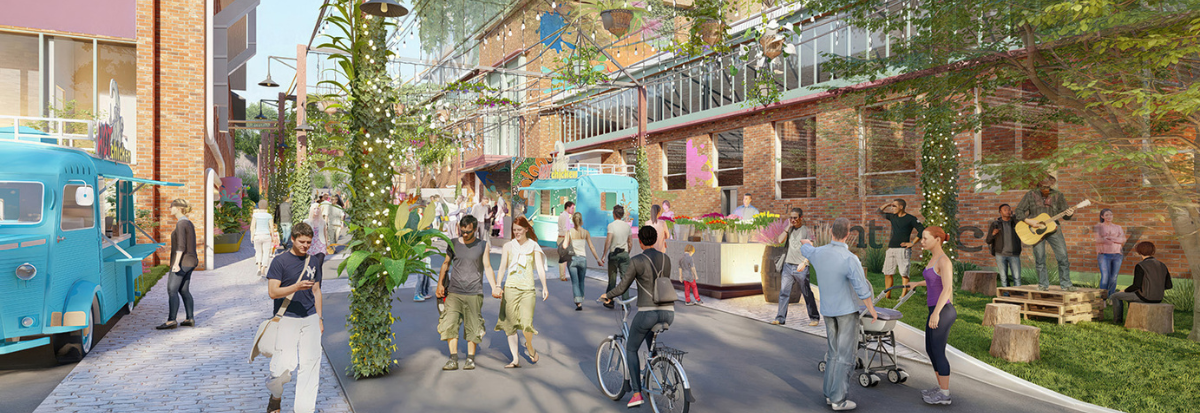Since we lodged a Change of Use application from industrial to mixed use with Brisbane City Council, we’ve had a lot of people express their interest in our plans for Australia’s first fully integrated Arts Village at 115 Hyde Road, Yeronga.
It’s incredible to see so many residents – from our immediate community, South-East Queensland, across Australia and overseas – invested in our project and asking various and engaged questions about our vision for this creative precinct.
We appreciate all the questions and want to make our responses more accessible to the wider community. To do so, we’ve collated all our commonly asked questions below.
Please note all answers below are subject to Council approval of the application and the Change of Use application is just the first step towards realising the vision for Australia’s first fully integrated arts village.
1. What are the next steps if Council approves The Paint Factory application?
The next step will be to enable upgrades to existing buildings to accommodate and expand the creative and community uses, which we are already fostering.
Following this, applications will be made for new buildings with a staged roll out. This will require detailed architectural and engineering designs that will be assessed against Brisbane City Council’s Planning Scheme.
We encourage you to join our database or follow our social media to stay up to date with The Paint Factory’s progress and future community sessions.
2. What uses are proposed for the site?
Our vision is to transform the old paint factory into Australia’s first fully integrated arts village, featuring event and gallery spaces, facilities for visual artists, apartments, communal zones, green spaces, street art, outdoor performance spaces, retail tenancies and more.
Other proposed uses for the site could include art studios, artist-in-residence studios, a boutique microbrewer tap and wine bar, café, coffee roastery and an artisan market space.
3. How long is the public notification period?
The Paint Factory’s public notification period began on 5 December 2023 and ends on 5 February 2024, giving the community two months to share their thoughts on the project.
This time was extended due to office closures within Council for Christmas break and to provide everyone adequate time to review the extensive plans and supporting documents.
If you are keen to make a submission but need support, please get in touch on 1800 962 011 and we can provide guidance on how to make a submission to Council.
4. Why didn’t you separate the application like Council suggested?
Brisbane City Council asked us to consider separating the application into two parts – the development permit component and the variation component.
The development permit demonstrates the intent of The Paint Factory, while the variation allows future land uses that are consistent within the Mixed-Use Zone to integrate into the Creative Arts Precinct.
However, after extensive discussions with leading urban designers and town planners, we decided to keep the application as one to clearly demonstrate how our plan will seamlessly integrate the creative arts precinct with the residential to create Australia’s first fully integrated arts village.
We strongly feel that separating these aspects would remove the intrinsic link to create a sustainable mixed-use space. We have provided extensive examples and reasoning behind this decision back to Council and would be happy to share this.
5. How does The Paint Factory align with Council’s city plans?
Council has provided clear policy intent to redevelop several transition sites across Brisbane, giving old industrial sites new life.
The old factory on 115 Hyde Road, Yeronga has been identified as one of the 12 transition sites in Brisbane City Council’s policy. This means they are planning to reinvigorate the site with mixed uses which align with their growth plans, including the need for more housing, creative opportunities, employment and tourism.
6. What are the traffic implications to the existing road networks?
The working and active factory was originally designed to receive large and small commercial vehicles, as well as many employee and visitor cars daily.
Our current Change of Use application includes a traffic engineering report. Within the report, an independent expert indicates that the existing road network, which facilitated the factory with heavy to medium vehicle movements, can adequately accommodate the likely demands of the project.
However, it is anticipated that an upgrade of the Fairfield Road / Hyde Road signalised intersection would likely be required to include an extension of the existing right turn lane on the Fairfield Road northern approach to the intersection. The level of traffic demand generated by Stage 1 of the project will be minor in the context of the existing performance of the key road network intersections.
7. How much of the existing factory are you going to keep and repurpose?
We intend to retain as much of the original buildings as possible to retain the 1950s industrial character. This space is the heart of the precinct, so we want to ensure we don’t lose its creative atmosphere and tone, which everybody loves so much.
In the event that demolition is required, we intend to reuse and repurpose materials from the original building as part of its redevelopment, contributing to our sustainability ethos.
8. How many carparks will be provided?
Given the site’s history as a working factory with staff and visitors accommodated, there are currently 116 carparks on site. We also have the ability to extend these numbers significantly for events on the northern grassy area at the rear of the site (near the soccer club) for when we have events.
If the current Change of Use application is approved, we can start finalising our staged plans for our next application to Council. This will outline key building details including the number of dwellings and associated carparks, which will need to be assessed and demonstrate compliance with planning requirements.
Active transport, car share, ride share and public transport will be encouraged to and from the site.
9. How many dwellings are proposed?
If the Change of Use application is approved, we will then be permitted to apply for land uses in accordance with our land use plan and mixed-use provisions.
This will outline key building details such as the number of dwellings and carparks for the extent of the development proposed as part of that application.
Dwelling numbers will also depend on future market conditions and product demand.
At this stage, it’s proposed to allow for a combination of between one to four storeys in the front portion of the site and between three to eight storeys for the balance of the site.
The intent is to create a vibrant village atmosphere that provides much-needed housing choice to the area and supports employment and creative activations in Brisbane suburbs.
10. How will you continue to support the arts and creative industry?
Our plan is to create a key destination for artists to live, create and thrive, with purpose-built facilities including studio spaces, exhibition and workshop spaces, storage space and central management offices.
It’s these purpose-built facilities that will help keep artistic talent in central locations and promote a sense of community.
Furthermore, The Paint Factory will continue to be a space where national and international artistic works are appreciated, shared and created.
The site supports Brisbane’s growth in the creative industry and will become a hub, with art studios, an art gallery, street art, performance spaces, sculpture gardens and storage spaces.
11. How do you intend to blend the arts with the residential component?
We feel the site naturally divides into two parts, consisting of the:
Urban Laneway precinct hub around the original administration buildings and the main factories. This will be the heart of the arts village, transforming it into an activated space surrounded by creative spaces, pop-up events, food trucks, markets and public art. This precinct will also include artist-in-residence apartments, art studios, art galleries, café and wine/tap bar, and community gathering places.
Urban Common to the rear of the factories on the city side, which will be framed by mixed-use residential with creative uses at least on the ground floor and then a predominantly residential precinct on the northern side towards the city.
The intention is for the front of the site to be where most of the creative arts and associated activities will occur. In this part of the site, there will be ground-floor activation and a maximum of 50% residential.
The majority of the residential precinct is located at the northern part of the site. This area will incorporate plenty of green space and the dwellings, mainly in apartment format, will enhance the site’s connectivity with pathways to surrounding sites, welcome new wildlife and vegetation, deep planting and sustainable building design (e.g. solar opportunities, roof top green spaces and end-of-trip facilities).
At the back of the site there will still be at least 20% of the ground floor activated with non-residential uses/centre activities such as gallery space or offices for creative businesses etc and lobbies for residential buildings.
If Council approves our Change of Use application, community consultation will continue while we finalise our staged plans for the next application to Council.
12. Why does The Paint Factory need residential?
The key focus for the local team is to ensure this project is sustainable for generations to come.
As shown by international examples of best practice in delivering successful arts villages, the key is employing integrated and mixed uses to ensure there isn’t one reliance on one use, and to ensure artists can continue to interact with the site in an affordable and creative manner.
It’s for this reason we believe the best option is to provide a mixed-use solution for the site which provides complementary uses and encourages people to live, create and thrive on site.
This mixed-use precinct will introduce a new creative lifestyle to the community, while also providing housing options and employment opportunities.
Further to this, in 2023, the National Housing Finance and Investment Corporation (NHFIC) forecast that Brisbane, a city gearing up to host the 2032 Olympics, will experience a shortfall of 12,300 homes within the next five years.
The Hyde Road precinct has also been identified as a ‘Transition Site’ under Brisbane City Council’s report ‘Brisbane: Our Productive City Strategy’. This report represents Council’s current review of Brisbane’s Industrial Strategy. The purpose of Council identifying this precinct as a ‘Transition Site’ is to identify industrial-zoned land that does not have long-term value for industrial purposes as a basis for suburban renewal.
Aligned with Brisbane’s Sustainable Growth Strategy which targets the current housing pressures for our growing city, our project will focus on meeting the strategy’s four priorities. These include increasing housing supply, diversity and affordability, suitable location and sustainable, liveable and well-designed homes.
The site is ideally located for residential purposes. It is a large parcel of land capable of providing much-needed housing supply, and is located within a well-established residential area, approximately 5 kilometres from the CBD.
13. What flooding implications will this project have on and offsite?
The level of the land that this project sits on is relatively high for Yeronga, with a very small percentage of the land sitting below the one-in-100-year flood line.
The project considered the historical and proposed flood design levels, recognising the philosophy of a net benefit improvement of flooding profile for the area that this site drains to.
The Planning Scheme provides the minimum floor levels to ensure appropriate flood immunity. Each future development application is required to be assessed by the Flood Overlay to the extent it exists on our site, and it is our intention to exceed these minimum levels.
Also, our independent reports show there will be no anticipated negative effects on adjoining Yeronga homes that are subject to creek, overland or river flooding.
14. Where can I find the full master plan?
A copy of our master plan is within our development application, please refer to appendix A “Master Plan” of the document.
Please note, if the Change of Use application is approved the built form and architectural plans will need to uphold our Green Initiatives Variation Plan, Height Variation Plan, Overlay Variation Plan, Land Use Variation Plan and Council’s Planning Scheme.
15. Why is the waterway corridor being removed?
Part of the site is within the Waterway Corridor Overlay, which is identified at the north-west corner of the site.
The removal of this mapping from the site is logical as the waterway corridor has been severed from the tributary connection due to filling, and therefore the extent of the corridor mapped on our site does not function as a waterway corridor. See below plan for further information and to view the small area in question.

16. What community infrastructure will you provide?
As with any development application in local government in Queensland, Council sewer and water providers (QLD Urban Utilities and Brisbane City Council) will issue infrastructure charges to the team based on the additional demand on the networks.
The contributions paid to Council are distributed to help establish or upgrade essential infrastructure such as transport (active and road networks), public parks and community facilities, and stormwater infrastructure.
However, further to this, our proposed project will encourage and increase connectivity and walkability internal to the site as part of the site’s proposed redesign.
The idea is to provide the Yeronga community with linking pathways and bikeways to make existing public transport and adjoining sites/uses more accessible. Along with this, we plan to request more regular buses to minimise the impact of additional traffic.
The site has also been designed to incorporate a number of green initiatives, including:
A number of potential linkages to connect the site to its surrounds as well as public pathways and bikeways for future residents and visitors.
Minimum 35% of the total site will be ‘green’, either provided on the ground plane or above, comprising green spaces which may include private open spaces, pools, planter boxes, urban gardens, arbours, landscaping, laneway/hardstand/plazas, grassed areas, planting, productive and formal gardens, ponds and stormwater treatment.
A minimum of 10% of deep planting areas across the site, which facilitates and supports landscaping outcomes suitable to sustain large subtropical planting.
Urban spaces for social interaction including the Urban Common, located behind The Paint Factory building, and Urban Laneway, located in front of The Paint Factory building with excellent access from Hyde Road. These spaces are designed to allow for activity and vibrancy to The Paint Factory site.
Significantly improve the land’s suitability for wildlife, vegetation diversity, water quality, climatic comfort and re-use of existing infrastructure.
Another key part of this project, which provides incredible community value, is the investment this project will place in Brisbane’s creative industries. It will create an inspiring and Australian-first destination which encourages people to create, view and engage in locally created high-level culture, as evidenced by the below plan.
Please see below our Green Initiatives Master Plan for more information.

17. How much green space will be provided?
We are pleased to be improving the environmental and green space values of the community.
A minimum of 35% of the total site area will be ‘green’, including a minimum 10% for deep-planting areas, but the final percentage going to be delivered is yet to be determined.
In contrast, development for industry on the site would not provide nearly as much green space as a minimum of 3% of the total site area to be provided is identified in the Planning Scheme.
18. Will you have any sustainability initiatives?
Yes, it is proposed the project will have leading urban design regarding energy usage that will utilise passive cooling, rooftop gardens, community gardens, community batteries, beehives on the roofs, green walls and solar-power generation, EV car share schemes powered by site-generated rooftop solar.
It is intended that solar-power generation will feed into onsite community power usage. We are also investigating community battery use.
19. How will this link in with existing services?
Reports are being submitted to the respective utility authorities to work either within existing capacity or enhance the services, where required.
The reports indicate our current plans will ensure impact to the surrounding community is minimal.
If you have any further questions about The Paint Factory project, please don’t hesitate to contact us here or on 1800 962 011.
Alternatively, we encourage you to review our Placebook which provides an in-depth explanation of how the integrated arts village will fuel Australia’s arts economy, promote a new lifestyle with creative living opportunities and put Brisbane on the map as a global city for creativity.


